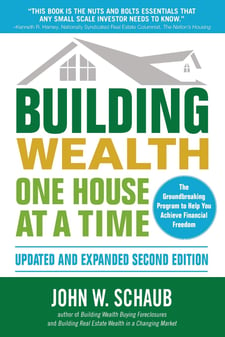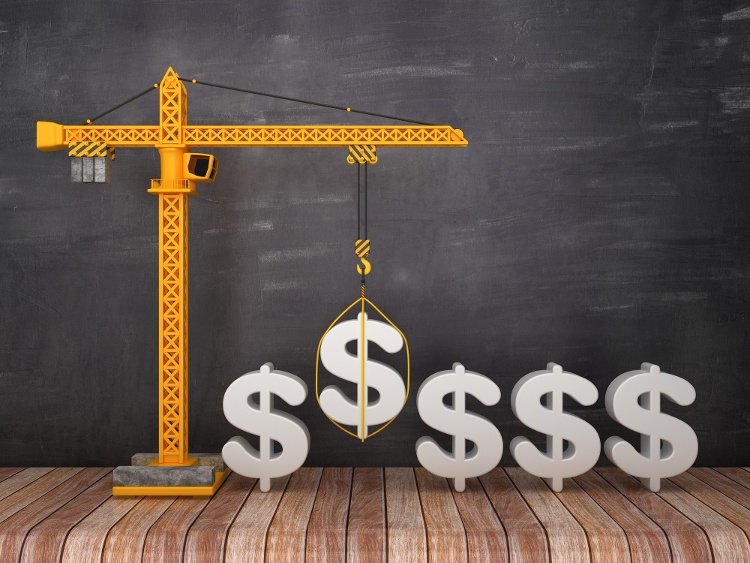John W. Schaub is a nationally recognized author and real estate investor with nearly 40 years of experience in buying, selling, and managing houses.

Build Wealth One House at a Time was originally published in 2005 prior to the Global Financial Crisis. The book was recently updated to meet the needs of real estate investors in today’s changing market.
In Building Wealth One House at a Time, 2nd Edition, investors learn fresh strategies for investing in single-family rental houses, including chapters on real estate market cycles, how to finance real estate, and why focusing on cash flow and appreciation over the long-term is the key to building wealth.
In today’s real estate market, virtually anyone can invest in single-family rental houses, pay off debt fast, and generate steady cash flow and income for life.
Key Takeaways / Lessons Learned
The book opens with words that almost everyone knows and agrees with, but surprisingly few people act on:
“Houses are not complicated, and they’re not scary. Their performance is predictable. They produce income when rented, and house rents have a long history of increasing.”
Let’s open this article by looking at a few of the key takeaways and most important lessons from Building Wealth One House at a Time, 2nd Edition.
Why houses make the best investments
Of course, house prices don’t go up every year, but those down market cycles can be the best time to buy. The phrase, “You make your money when you buy, not when you sell” has a dual meaning for rental property investors:
- In order to make money on a house you have to buy one, not just look at them
- Buying a house that no one else wants can generate significant profits
There are six reasons why single-family houses make better investments than any other asset class:
- Houses can make more money with less work.
- Houses provide cash flow, but their value doesn’t depend on the income generated.
- Homeowners sell because they have to and aren’t experienced investors like those found with commercial real estate.
- Lenders prefer to make loans on single-family houses because they’re lower risk and easier to manage.
- Diversifying is simplified with individual houses, leading to increased investment safety and higher profits.
- Easier to identify trending factors that make a market good to invest in: population growth, demographics, local government regulations and zoning laws, and inflation.

3-Step Free and Clear Plan
John Schaub’s Free and Clear Plan is a simple, logical 3-step plan for building wealth. As the author writes:
“The first step is to set a goal for the number of free and clear houses that you want to own. Work backwards into this goal by first setting an income goal and then asking how many free and clear houses you will need to produce that target income.”
- Set a goal by deciding how much monthly net cash flow you want and determining how many houses you need to get there.
- Buy one good house at a time, at the right price and terms, and hold while it appreciates in price and cash flows.
- Own your houses free and clear by using the cash flow to pay off debt quicker, strategically sell some houses to pay down the debt on others, or refinance some houses to pay off other.
On this last point, Building Wealth One House at a Time, 2nd Edition makes an interesting observation about debt and leverage. If you have two houses, it’s better to have a debt of 80% on one and 0% on the other, rather than a 40% LTV on both.
That’s because as a real estate investor, you have more negotiating power with the lender with a conservative 80% loan-to-value. Conversely, the more equity you have the less likely the bank is willing to work with you, because they know you’re highly unlikely to walk away from the property.
The best way to keep rents high, vacancies low, and minimize tenant problems
Single-family rental property investors and their property management companies spend a lot of time and effort finding and keeping great tenants. The fact is, it’s much easier to maximize cash flow and minimize problems when you own what the ideal tenant is looking for.
John Schaub suggests investing in rental houses that match the eight core wants of the ideal tenant – renters who pay on time, renew their lease, and treat the house as if it were their own:
- A house in a safe neighborhood
- A house big enough to hold all their stuff
- A house that is clean and in good repair
- A landlord who will maintain the property
- Fair rent
- Fair rent raises
- Privacy
- A house that is not for sale
John knows that based on his personal experience, his breakeven point with a tenant is two years. If they stay two years or longer, he turns a profit. But, if they move after one year, he loses money due to vacancy and turnover repairs. By sticking with these eight core needs, John’s tenants normally rent for five years or more.

Chapter/Section Summaries
There’s literally something for everybody in Building Wealth One House at a Time, 2nd Edition. Let’s begin with a punch list of each chapter. After that, we’ll take an in-depth look at a few of our favorite chapters:
- How Buying One House at a Time Can Make You Wealthy
- Buying the House That Will Make You the Most Money
- Real Estate Bubbles, Crashes, and Cycles
- Finding Opportunities That Others Miss
- Knowing What a House Is Worth Before You Make an Offer
- Knowing How You Are Going to Pay for a House Before You Buy
- What Makes Some Debt Dangerous and How to Borrow Safely
- Borrowing Without Going to the Bank
- Attracting and Using Investor Money to Increase Your Profits
- Using a Real Estate Contract to Your Advantage
- Making the Offer
- Secrets of Professional Negotiators
- Buying and Selling with Agents
- Buying and Selling Houses to Produce Cash Flow - Today
- Selling on Lease/Options to Generate Larger Profits
- Finding and Buying Preforeclosures and Foreclosures
- Attracting and Training Long-Term, Low-Maintenance Tenants
- Knowing When to Sell and How to Sell
- Getting Your Houses Free and Clear
- Making It Big on Little Deals
- The Fuller Center for Housing: Helping Others Build Wealth, One House at a Time
Best Chapter for Understanding What to Buy and Why
“Buying the House That Will Make You the Most Money” is chapter 2 of Building Wealth One House at a Time, 2nd Edition. It’s the perfect starter guide for beginning real estate investors and also provides an excellent back-to-basics reminder for seasoned investors.
Once you’ve developed your own unique investing game plan and understand the eight core factors that great tenants are looking for, the next step is to buy a house to rent to those excellent tenants.
John begins this chapter admitting that, while no house is perfect, you can increase your profits significantly by targeting certain types of houses to buy. Simply put, buying houses with a plan allows investors to make more money sooner.
Buying different houses for different reasons. It’s easier to diversify and scale up when you invest in individual single-family rental houses. Unlike a commercial shopping center or large apartment building, you’re not putting all of your eggs in one investment basket, so to speak.
Owning houses with different square footage, construction dates, and price points is safer than owning one big property because your income and expenses are spread out among many properties in your portfolio.
For example, less expensive starter homes generate more cash flow and usually appreciate at a higher rate than new construction, because newly built homes are more expensive. Starter homes rent well and usually faster, no matter what cycle the economy is in.
The next step up from owning starter homes is to buy slightly larger houses in slightly better neighborhoods. Generally speaking, homes that are one step up from starters have two advantages.
First, they will attract longer-term tenants because the house is bigger, and there’s more room to raise a family and store ‘stuff’. Secondly, more expensive homes usually generate less income when measured on a square foot basis but will also produce larger capital gains, helping to keep taxable income lower, especially when combined with a 1031 tax deferred exchange.
Regardless of what type of houses you target, there are a few key concepts to keep in mind:
Buying in the best neighborhood that you can afford makes it easier to attract tenants – and buyers, when the time comes to sell. Factors that make a neighborhood “good” include proximity to parks and recreations, jobs and shopping, and school district rating.
Buying a house that will attract and keep a long-term tenant usually means a 3-bedroom, 2-bath or larger, although the size will vary based on the market and tenant demographic. In general, although larger homes may have higher maintenance, they are also attractive to multi-generational renters seeking to share housing costs as home prices and rents continue to rise.
Some houses are too big or too fancy for investment because there’s not always a correlation between luxurious amenities and ROI. Fragile or high maintenance features such as elaborate landscaping or swimming pools increase operating expenses and the risk of negative cash flow. Instead, buy a house that is functional and well located and keep it in good operating condition.
It’s the lot that goes up in price, not the house. That’s because a house is a depreciating asset, but the land it’s built on is not. Investors should try to buy a house on the best lot possible, avoiding busy streets, odd shaped lots, and corner lots that usually have a larger high-maintenance front yard on two sides but a tiny yard in the back.

Best Chapter for Safely Using Leverage
“What Makes Some Debt Dangerous, and How to Borrow Safely” is chapter 7 of Building Wealth One House at a Time, 2nd Edition. In this part of the book, John explains that there is good debt and bad debt, and smart real estate investors understand the difference between the two.
Consumer debt is an example of bad debt. People who always have high levels of consumer debt will almost always be poor because interest rates are high, terms are short, payments are high in relation to how much you owe, and the interest isn’t deductible.
On the other hand, business debt (including credit card debt) can be used as a business tool to invest in income-producing real estate and purchase materials and supplies that are fully tax deductible business expenses. As long as the credit card bill is paid on time, it’s like having an interest-free loan for your business one month at a time.
Real estate loans can be both good and bad. Factors that can make some real estate loans dangerous include:
- Short term loans of five years or less are not long enough for a normal real estate market cycle, putting borrowers in the position of having to refinance or sell in a down market
- Variable interest rates can boost cash flow in the short term but eat away at profits when rates rise, especially if rents in the market drop over the short term
- Personal guaranties and recourse loans allow a lender to go after all of a borrower’s personal and business assets even if only one property is foreclosed on
With these negatives in mind, John also offers four rules for borrowing safely:
- Buy properties that produce enough rent to pay the expenses and repay the loan
- Buy properties that are relatively easy to manage and easy to sell
- Avoid personal liability on any high-risk loan
- Borrow with the longest term possible because you can always pay it off early
The conservative use of leverage allows real estate investors to increase yields and strategically grow a rental property portfolio using other people’s money. Of course, using too much leverage can lead to unintended consequences of negative cash flow and equity if the real estate market begins to cycle downward.
Schaub’s Laws of Leverage provide a guide to using leverage wisely:
- Leverage can increase or decrease cash flow
- Negative leverage reduces your cash flow
- Leverage can increase or decrease your risk
Best Chapter for Maximizing Cash Flow
Chapter 14, “Buying and Selling Houses to Produce Cash Flow – Today” explains why it’s better and safer to focus on cash flow instead of gambling on short-term gain.
While buying and selling a house for quick profit can give an investor an adrenaline rush, focusing on short-term cash flow also takes more time and has more risk. In fact, many people who try to mimic the fix-and-flip success of reality TV shows often end up failing because they underestimate the skill and time it takes to buy low and sell high in a short period of time.
On the other hand, using a long-term buy-and-hold strategy requires less skill and effort, especially when investors use a local professional property management company.
Thanks to the power of appreciation, even if you buy at close to retail you should still make a profit if you hold the house long enough. In the meantime, a house in a good location will provide consistently solid cash flow over the holding period. So, the longer you hang onto the house, the more money you can make through that winning combination of cash flow plus appreciation.
On the cash flow side, John advises investors to purchase well designed and well built houses in neighborhoods that will attract long-term tenants and appreciate at an above average rate. Then, follow five steps to find deals that make sense with equity built right in:
- Identify the price range of houses in your market that sell the fastest.
- Find several neighborhoods that have houses for sale in the price range you want to invest in.
- When you find a “good deal”, research it to find out what the owner paid and what the comparables are for similar houses nearby.
- Set a minimum profit price net of any needed repairs, keeping in mind that the more work a house needs the more time and money you will spend without generating income.
- Keep a reference journal that records the following points:
- Why you thought the house was a good deal
- Process you followed to come up with your first offer
- How the seller responded to the offer
- What the final accepted offer was (or why the deal was never put together)
- How you would change the offer negotiation process if you had to do it again.
Toward the end of the chapter, investors are reminded that there are some houses that should never be purchased regardless of the price. Signs that it’s better to take a pass than to try and make a deal include:
- Houses with repair costs that exceed market value
- Neighborhoods with few owner occupants and no trend toward more owner occupants
- Buying a house “as is” that needs a lot of work transfers the seller’s problem to you.

Best Chapter for Minimizing Risk
"Making it Big on Little Deals” is chapter 20 of Building Wealth One House at a Time, 2nd Edition. This part of the book begins by acknowledging that to make money as an investor, you have to take risks. If the risk is small – in other words, if the deal is little – you’re more likely to take the risk because there’s less to lose.
For example, buying an average priced house in a good neighborhood can be almost like having a risk-free investment if you know how to buy, finance, and manage the house well. It takes a modest amount of work to find, buy the house using a conservative down payment, and rent it to a good tenant who will pay a high enough rent to cover the operating expenses and the monthly mortgage cost.
Investors can significantly minimize their risk by learning as much as they can before buying their first rental property and writing down a plan for building wealth. John suggests investors commit to buying at least one house a year and hold onto the house until it doubles in value. Over the entire holding period, cash flow from rental income should also increase every year.
In this second-to-the-last chapter of his book, John lists several thoughts about investing from billionaire Warren Buffett:
- Buy investments that have real value at a bargain price. Make a good deal on a house by knowing its true value and the income it will produce and buy only if the price is right.
- Hold on to your good investments forever. If a house rents well and is appreciating, don’t sell it because it is making you a lot of money.
- Sell losers as soon as possible. Even the most experienced investors make mistakes. When and if you make a mistake, admit it and get rid of the property. Recognize what happened and learn from the experience.
- Follow the Golden Rule. It’s possible to make a lot of money investing in rental property when you treat others as you would like to be treated. When you treat people well, they will send referrals and business your way without having to be asked.
- Real estate investing offers an unlimited opportunity to build wealth. By buying one house at a time and holding them until they double in value, you can create more wealth in a short period of time than 90% of your friends and neighbors will ever have in their lifetimes.
Is the Book Worth Reading?
There’s a lot to be learned by reading Building Wealth One House at a Time, 2nd Edition. The book is action-oriented and covers quite a bit that both beginning and experienced real estate investors need to know.
Here’s a list of some of the strong and weak points of the book.
Positives about the book
- Well written and gets to the point fast with actionable information you can put to use right away.
- Encourages taking action and discourages “analysis paralysis.”
- Focuses on the importance of long-term cash flow plus gradual appreciation of house values as the best way to create profits in real estate investing.
Negatives about the book
- Makes certain assumptions about inflation and housing appreciation that may or may not hold true today.
- With his 10-10-10 Rule, John encourages investors to highly leverage property with only a 10% down payment, creating a high mortgage payment that may lead to negative cash flow.
- Good basic information for beginning investors but short on specifics that experienced real estate investors may be looking for.
Conclusion
Building Wealth One House at a Time, 2nd Edition covers key real estate investing concepts such as:
- Why single-family houses make the best investments
- How having 80% debt on one property and 0% on another is better than having 40% debt on each one
- Choosing a house that will keep tenant turnover low and rents high
- Using leverage to maximize returns
- Recognizing and capitalizing on real estate cycles
- Improving negotiating skills
- How to avoid common and potentially costly mistakes many real estate investors make
The book offers actionable suggestions that new investors can put to use right away, and also provides a good review of concepts that experienced investors may have learned long ago but aren’t fully putting into practice today.









